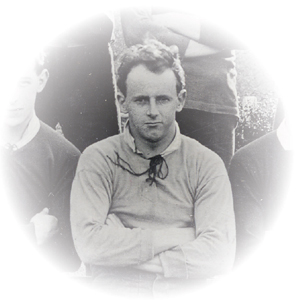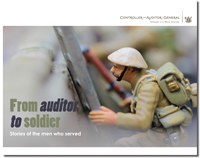Victor Raymond Bernard
 Victor Raymond Bernard was one of four boys in a family of 10 children. The family lived originally in Masterton, but moved to Wellington, where Victor attended Wellington College from 1905 to 1908.
Victor Raymond Bernard was one of four boys in a family of 10 children. The family lived originally in Masterton, but moved to Wellington, where Victor attended Wellington College from 1905 to 1908.
He joined the Audit Department on leaving school in 1908, and studied accountancy at university. The family were very proud of him, as he of all the family got the opportunity to do more than just learn a trade.
At the outbreak of WW1, Victor had attained the position of Audit Examiner, Class VII.
In August 1914, when Victor was 23 years old, he joined the New Zealand Expeditionary Force. He was part of the Samoan Advance Party that embarked in August 1914, and returned to New Zealand in April 1915.
Victor evidently then returned to the Audit Department for a period, because he appears in a photo of a 1915 office football team. He was no doubt a useful member of the team, having been in the first XV in his last year at Wellington College.
In September 1915, Victor applied for the rank of Staff Sergeant in the New Zealand Army Pay Corps. In his letter of application, he said that, since his return from Samoa, he had been attached to the defence audit section and had gained a thorough knowledge of the pay system. Victor’s letter of application also said that he had a thorough knowledge of Treasury Regulations, Imprest Systems, and “a fair knowledge of accountancy”.
Victor was appointed to the Defence Audit Unit in November 1915, with the rank of Private, not the rank of Sergeant that he had sought.
In October 1916, Victor was posted to the New Zealand Army Pay Corps in Cairo. He was promoted to Staff Sergeant in November 1916.
The Army identified that Victor had the qualities sought in a leader. In May 1917, he was sent to Oxford, England, to be trained as an officer. He was promoted to the rank of 2nd Lieutenant and attached to the New Zealand Rifle Brigade.
In September 1917, 440 officers and other ranks, including Victor, returned to New Zealand. Some returned to take up other duties and some were no longer fit for duty. Victor’s military record notes that he was “seconded for duty in NZ”.
Victor used his leave to visit his family. On returning from leave in February 1918, he reported for duty at Trentham Camp. A New Zealand Gazette Notice of June 1918 included Victor in a list of officers being recalled to active service. In June 1918, he left New Zealand to serve with the New Zealand Rifle Brigade in France.
The Official History of the New Zealand Rifle Brigade mentions an action involving Victor that took place on 5 October 1918, outside the town of Crèvecœur, France:
On receipt of orders Lieut. Kenrick promptly commenced the forward movement, sending 2nd Lieut. C. W. Rule’s platoon against the northern bridge, while 2nd Lieut. V. R. Bernard was instructed to force that to the south. It was at once evident that if the enemy had really commenced a withdrawal it was not his intention to retire to any great distance. Rule’s men crossed with comparative ease. Bernard’s platoon, however, was confronted with a machine-gun post established in the lock-keeper’s house, but this was successfully dealt with, and the garrison of eighteen men with their two machine-guns was captured and sent to the rear. The initial stage thus successfully completed.
A month later, on 4 November 1918, Victor was killed fighting in Le Quesnoy in France, a week before the war ended.
The assault on the ramparts at Le Quesnoy had been launched by the 3rd Brigade Group, A and B Companies. Victor was in A Company but it is not known if he was killed earlier in the day in the assault on German positions outside the town or was killed during the assault on the town.
The ladder assault is portrayed in a painting completed in 1920 by George Butler, a New Zealand war artist.
In July 1923, Le Quesnoy erected a memorial for the New Zealand soldiers, with the English wording on the memorial reading:
In honor of the men of New Zealand through whose valour the town of Le Quesnoy was restored to France 4th Nover 1918
The memorial is a large stone sculptured panel set into the ancient town walls, showing the New Zealanders scaling the wall, being watched over by a large winged figure symbolic of peace.
Victor is buried at Cross Roads Cemetery, Fontaine-au-Bois.
He was posthumously awarded the 1914-15 Star, the Victory Medal, and the British War Medal.
Victor’s nephew, Dr F Rayner Bernard of Tauranga, has told us about a letter the family received in 1919 from Joseph Firth, the long-serving Headmaster of Wellington College. This was a handwritten letter of condolence sent by Mr Firth to the families of each of the Wellington College old boys who died in the war.

